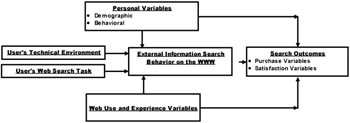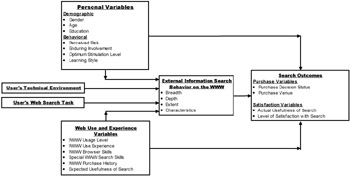Model Development
|
| < Day Day Up > |
|
The unique characteristics of any consumer-shopping environment must be taken into account when developing a model of consumer search behavior. One example of this approach is that of Titus and Everett (1995) who, in their model of a physical consumer shopping environment, included such environmental characteristics as the environment's "legibility" and its "stimulation characteristics". These characteristics, which are respectively similar to the navigability of an environment (e.g., Passini, 1984) and the "atmospherics" of a store (Donovan, Rossiter, Marcoolyn and Nesdale, 1994) can also be applied to the unique hypertext shopping environment of the Web. The Web is generally accepted as incorporating low levels of environmental legibility and high levels of environmental stimulation. It is thus a highly stimulating and 'noisy' environment for consumers (Hodkinson and Kiel, 1997). However, the specific environmental characteristics an individual experiences while using the Web will depend upon (1) the technical characteristics of the Web access being used, and (2) the particular Web sites the consumer visits.
The 'technical characteristics' of the Web access being used include the speed of the ISP and the speed of the local data link, the version of the Web browser being used and the settings extant upon the particular PC at that time. These variables and many more affect the speed of data display and the Web features and utility available to the user. The combination of these features defines the technical environment in which the consumer operates at a point in time. Thus, for any single Web search such characteristics are taken as a 'given'. For this reason the technical characteristics of the Web access being used will not be included in this model. However, if specific comparisons are to be made between the search behaviors of consumers, then differences in their respective technical environments must be taken into account.
The environmental legibility and stimulation experienced by a consumer during a conventional shopping trip will vary depending upon which stores he or she visits. The Web is a heterogeneous shopping environment, within which the effect of differences in individual Web sites are assumed to be random when observed over a number of users and a number of search topics. Thus, while the environmental characteristics of the sites a Web user visits will vary, they are assumed to vary randomly when considering many consumers and many Web 'shopping trips'. For this reason, the environmental characteristics of Web sites will not be included as a factor in the model. By contrast, the characteristics of each Web information search task are unique; for example, some search tasks will require the comparison of numeric data such as price and size, whereas other tasks will require the retrieval of expert opinion or consumer reports. Thus the search task will be included in the model.
The proposed model shown in Figure 1 has six major categories of variables. They are: (1) the user's technical environment, (2) the user's Web search task, (3) personal demographic and behavioral variables, (4) Web use and experience variables, (5) external information search variables, and (6) search outcome variables. The third variable category, that of personal variables, captures the characteristics of the consumer. These include the demographic variables of age, gender and education, and behavioral variables including perceived risk, enduring involvement, optimum stimulation level and learning style. The Web use and experience variables include Web usage level and experience, Web browser skills, special Web search skills, and real-life Web purchase history. The third major group of variables, the external information search behavior variables reflect the characteristics of Web exhibited search behavior and include the breadth, depth and extent of Web search and other measurable characteristics including duration, pace and the range of search actions utilized. The fourth group of variables—search outcomes—comprises the purchase variables namely, purchase decision status, proposed purchase venue, and satisfaction variables comprising the perceived usefulness of the search, and the level of satisfaction with the Web search activity. The detailed model of Web information search behavior is shown in Figure 2. Since the technical environment and the Web search task variables have been discussed in detail in the preceding section, the next section will discuss the latter four variables.

Figure 1: The Simplified Model of Web-Wide Information Search and Its Outcomes

Figure 2: The Detailed Model of Web-Wide Information Search and Its Outcomes
|
| < Day Day Up > |
|
EAN: 2147483647
Pages: 191